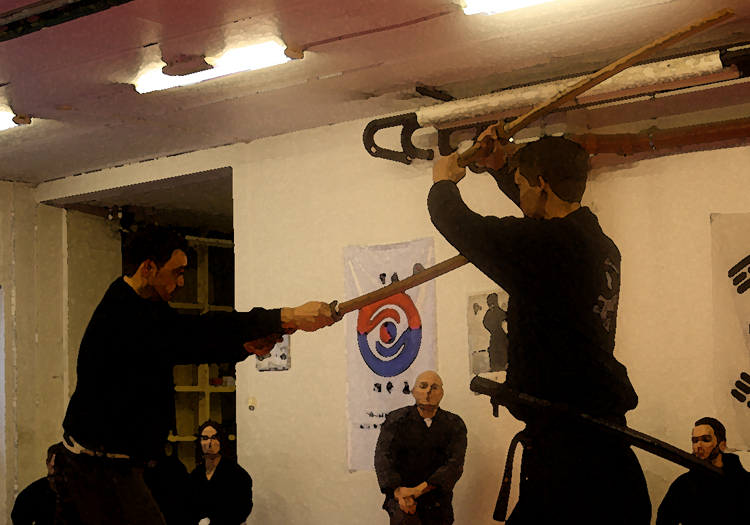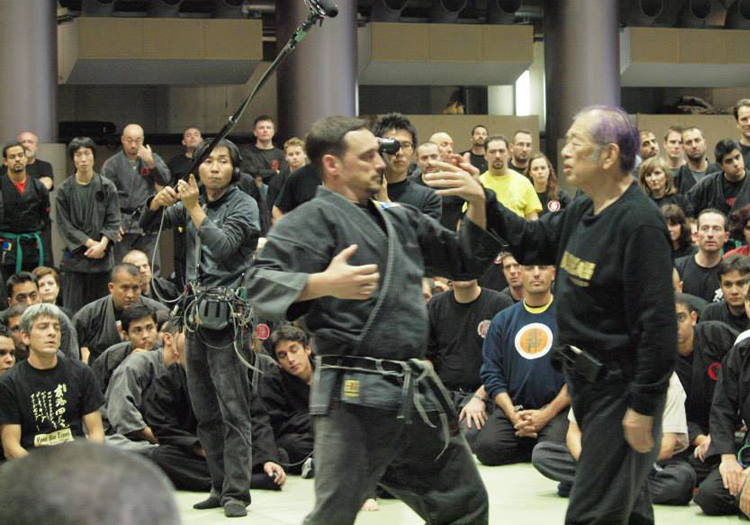About Bujinkan Gray Dōjō
From Japan, Around the Globe, to New Zealand
I founded Bujinkan Gray Dōjō in Ibaraki, Japan on July 1, 2000 with the blessing of Hatsumi Sensei and Shiraishi Sensei, who told me it would be beneficial to my development as a martial artist.
Since 2002 I have regularly been invited to give training workshops overseas, and have continued to do so several times a year. These "warrior pilgrimages"
("Shugyō") have been wonderful training experiences that have allowed me to serve the Bujinkan by sharing the feeling of many years of training in Japan
with others. The international nature of the Bujinkan is one of its greatest strengths, and I am very grateful to Hatsumi Sensei for providing an
environment that makes this international exchange possible. I have made so many good friends through the Bujinkan over the years and can only say
a heartfelt thank-you to Sensei for making that possible.
After moving from Japan to New Zealand and getting settled, I began offering regular
classes in the Wellington Region in January 2017. It's been exciting to see the group evolve
with first-time beginners as well as others who have had prior experience in the Bujinkan
and other martial arts. While I was living in Japan, Hatsumi Sensei remarked a number of
times at how I attract good people to my Dōjō, and it's been good to see that this is the
case here in New Zealand as well.
Get in touch to join our martial arts classes in Wellington & the Wairarapa!

Saturday class in Ibaraki, circa 2003

Training in Wellington, 15 years later
About Bujinkan Budō Taijutsu
The Organization and the Art
The Bujinkan organization was formed in the early 1970's as the umbrella organization under which
Hatsumi Masaaki Sōke ("Grandmaster") transmits the teachings of the martial arts Ryū-ha ("traditions" / "schools")
which he in turn received from his teacher,
Takamatsu Toshitsugu Sōke. These Ryū-ha follow an unbroken lineage back through
hundreds of years of Japanese history. The roots of the Ryū-ha themselves are said to be 3,000 years old.
Although Hatsumi Sensei possesses Denshō ("scrolls") which designate him as the Sōke of many different Ryū-ha, the Bujinkan
itself is officially comprised of the following 9 Ryū-ha:
These Ryū-ha were formed during the centuries of civil war which preceded the unification of Japan under the
Tokugawa Shogunate in 1603.
Their teachings have not been watered down for the sake of sporting applications, as is the case with most other Japanese martial practices,
but have been faithfully handed down as methods for dealing with real-life conflict-resolution situations. As these teachings have been tested
on the battlefield, they are well-suited to self-defense situations where there is no ring and no rules.
With no rules, there are no rule-based competitions such as tournaments or other such sporting events in the Bujinkan.
Training is mainly done through study and practice of various scenarios involving 1 or more opponents, either empty-handed or with a variety of tools.
Training is done in a safe and controlled manner, at a level of intensity that training partners are comfortable with.
| Ryū-ha Name | Meaning | Founding Year |
|---|---|---|
| Gyokkō Ryū | Jade Tiger School | 1207 |
| Kotō Ryū | Tiger-felling School | 1542 |
| Takagi Yoshin Ryū | Takagi Raise-the-Heart School | early 1600s |
| Shinden Fudō Ryū | Divine Transmission Immovable School | early 1300s |
| Gikan Ryū | Regard for Justice School | 1558-1570 |
| Kukishinden Ryū | Kuki Divine Transmission School | 1330 |
| Gyokushin Ryū | Jade Heart School | mid 1500s |
| Kumogakure Ryū | Concealing Clouds School | mid 1500s |
| Togakure Ryū | Concealing Door School | 1162 |

Hatsumi Sōke demonstrates use of Japanese armour ("Yoroi", 鎧). Study of such traditional methods is not only informative in the cultural sense,
but teaches efficient use of body dynamics that enables one to move freely when loaded with heavy clothing and gear.

No rules means expect the unexpected! Thinking out of the box and learning to use strategies that an opponent doesn't expect keeps us on our toes and develops a
flexible, creative outlook to problem solving.
Photos








